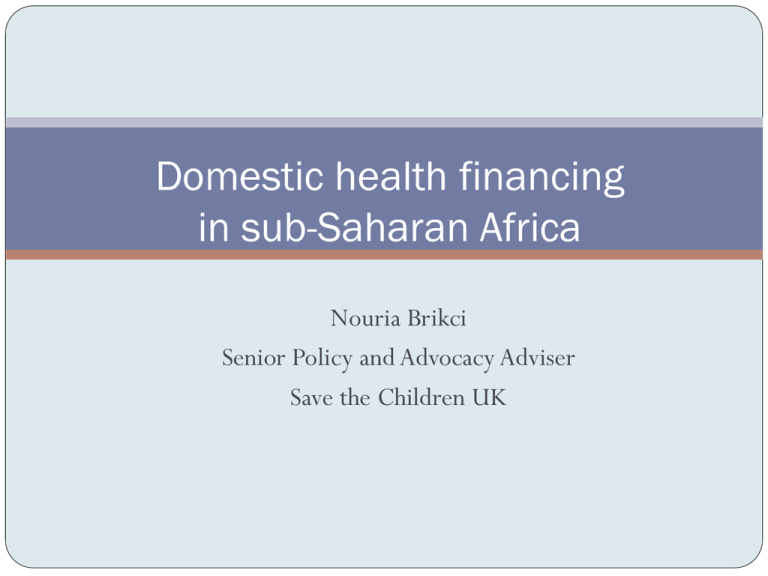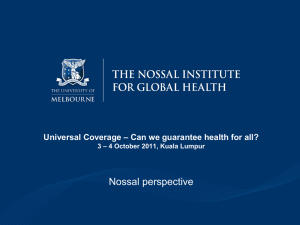Domestic Health Financing in Sub-Saharan Africa
advertisement

Domestic health financing in sub-Saharan Africa Nouria Brikci Senior Policy and Advocacy Adviser Save the Children UK Structure of the day Some theory and sharing of experiences (session 1) Some feasibility discussion of financing reforms in SSA (session 2) Case study of Tanzania (session 3) Group work: role play (session 4) Structure of presentation Some background definitions 2. Why health financing matters in general and for health governance particularly 3. Outline of each financing mechanisms - pros and cons 4. Conclusion 1. Objectives Participants get broad understanding of health financing theory and how relates to health governance Participants are able to understand and analyse health financing debates in their countries/ work Participants share experiences/ problems from their own contexts 1. Definitions Universal coverage: achieving universal coverage means: Providing all people with access to needed services of sufficient quality to be effective Ensure that use of those services does not expose user to financial hardship Health financing • Revenue collection: way money is raised to pay health systems costs • Pooling of resources: accumulation and management of financial resources to ensure that financial risk is borne by all pool members • Purchasing of services: process of paying for health services Principle key to governance: Equity horizontal equity, i.e. equal treatment of equals (thus equal expenditure, utilisation or access for equal need, equal health outcomes) vertical equity, i.e. unequals being treated differently according to the same criteria (thus unequal treatment for unequal need or unequal payment for those with unequal incomes). 2. Why health financing matters An essential WHO health system’s pillar Relevance to health governance : Equity and well being central - universal coverage Tool for participation and reaching best interest of population Link with transparency/ accountability Should allow responsiveness 3. Various health financing mechanisms Private Public User charges Social Health Insurance (SHI) Community Based Health Insurance (CBHI) Taxation (direct, indirect, general, earmarked) Private Health Insurance (PHI) Medical Savings Accounts (MSAs) Informal payments Mixed methods User fees/ charges Pros – – – – Raise revenue for health Reduce frivolous demand Cost containment Exemption mechanisms can protect vulnerable Cons – Limited revenue raised – Constrains necessary demand - Frivolous demand not an issue in poor contexts – Very regressive – push people into poverty or debt – Exemption mechanisms do not work – Discourage early care seeking Consensus: need to remove fees – how and what to replace them with? The Sudden and Sustained Impact of Abolishing User Fees Total Monthly Outpatient Attendances in Kisoro District 1998-2007 60000 Utilisation Rate 1.6 visits per person per year 50000 40000 User fees abolished 30000 20000 200% increase 10000 0 Jan 98 Jan 99 Jan 00 Jan 01 Jan 02 Outpatient attendances Jan 03 Jan 04 Jan 05 Jan 06 12 month moving average Jan 07 Source: MoH SL, six month review, unpublished report User fees removal in SSA Sénégal 2006 - Free deliveries Sierra Leone April 2010- Free care for pregnant and lactating women and children under five All services free - Libéria february 2007 Free care for C Sections and under fives – Sudan feb 2008 Uganda March 2001 : all services free Tanzanie 1993 – free services for under fives and maternity Niger 2006 – free services for under fives and pregnant women Kenya October 2007 – free deliveries Ghana May 2008 - free for under fives and pregnant women Madagascar 2008 – free deliveries Burundi Aug 2006 – free for under fives and deliveries Zambie april 2006 – free in rural areas Malawi – remained free Lesotho January 2008 – free primary care South Africa – free primary care Zimbabwe Aug 2010 – free for pregnant women How to remove user fees 1. Initial situational analysis Evaluation of user fee rates Success of exemption policies How revenues used Impact of revenue foregone at health centre level 3. Additional needs in terms of drugs and HRH 4. Where additional funds will come from 5. Communication 2. McPake B, Brikci N, et al (forthcoming), Removal of user fees - learning from international experience, Health Policy and Planning 2011 Community-Based Health Insurance “any scheme managed and operated by an organization, other than a government or private for-profit company, that provides risk pooling to cover all or part of the costs of health care services” – usually voluntary Pros – potential ability to collect revenue – pool funds – reach population groups that market based health financing arrangements do not, such as population in the informal sector and socially excluded groups Cons – – – – – 14 small pool of funds/ fragmentation Limited financial protection Limited revenue collection Poorest excluded Difficult to transform into national level system Private Health Insurance Limited role in low-income countries Pros – enable the healthcare of the relatively affluent to be self-financed, – free up public resources – encourage innovation and efficiency Cons – discriminates in favour of healthy and young adults who use little care – lead to market segmentation, cream skimming and exclusion of vulnerable groups (such as the poor, ill and elderly) – creates a two-tier health system, where those with private health insurance can access better quality services. – When subsidised by the state, it can prove to be very expensive for the government. 15 Social Health Insurance Definition: legally mandatory to obtain HI with a designated (statutory) 3rd party payer through contributions or premiums not related to risk that are kept separate from other legally mandated taxes or contributions Pros • Relate initial payment to income rather than risk, • Increase financial accessibility • Potentially large risk pooling ie subsidisation/ redistribution • Increase transparency - politically acceptable Cons • Tax on payroll: can increase overall production cost • Focuses on formal sector • Can create two tier health system • Tends to exclude those in greatest need • Feasibility issues in SSA 16 Tax financed systems General pros • Payment related to income • Progressive • Potentially very large risk pool • Still largely untapped in SSA General cons Feasibility issues: administrative capacity, tax avoidance Lack of transparency General or hypothecated tax? General taxes: Pros • Draws on broad revenue base • Allows trade-offs between health care and other areas of public expenditure Cons • Lack of transparency • Linked to economic growth • Feasibility issues: administrative capacity General or hypothecated tax? Hypothecated taxes: Advantages • Ensures stable and increased revenue back • More transparent hence decreases resistance to taxation • Separates health from competing national priorities • Improved accountability • Less susceptible to political manipulation Disadvantages • Hypothecation could be solely cosmetic • Too dependant on economic cycles • Can lead to rigidity in budgetary system where expenditures are linked to revenue generated and not to policy decisions • May be to advantage of powerful pressure groups Direct or indirect tax? • Direct taxes on individuals, HH and firms and collected by government • Indirect taxes on transactions and commodities Direct taxes Advantages: • Usually progressive • Administratively simple when records of income etc exists Disadvantages: • if informal market is large then need strong institutional capacity • can create horizontal inequity: – When income tax rates vary geographically – When some form of income are exempt from income tax – When some forms of expenditure are tax deductible Direct or indirect tax? Indirect taxes Advantages: • highly visible • can promote heath if tax on health damaging goods Disadvantages: • Indirect taxes are overall regressive as related to consumption not overall income. In particular: – People with higher income save more and savings are not subject to indirect taxes – People with lower income spend proportionately more of their income on heavily taxed goods (ie food) – Many indirect taxes are set as lump-sum amounts (for example vehicle licenses) Tax Financed Systems Not politically acceptable? Hypothecated tax Large informal sector? Example of Ghana Poor economic growth? Tax other sectors such as corporations Lack of admin capacity? Regressive tax rates 22 Conclusion Health financing key to governance Health financing sits within health system No perfect answer Universal coverage/ equity User fees to be removed CBHI limited scope/ success Public financing mechanisms best in principle Thank you ...and some literature World Health Report (2010), Health systems financing – the path to universal coverage, available at www.who.int McIntyre D, Gilson L, Mutyambizi V (2005) Promoting equitable healthcare financing in the African context: current challenges and future prospects, Equinet Discussion Paper Number 27, October 2005, available on http://www.equinetafrica.org/bibl/docs/DIS27fin.pdf Mills A (2007), Strategies to achieve universal coverage: are there lessons from middle income countries?, World Health Organisation, available on http://www.who.int/social_determinants/resources/csdh_media/universal_coverage_2007_en.pdf Di john J (2006), The Political Economy of Taxation and Tax Reform in Developing Countries, Research Paper No. 2006/74, UNU World Institute for Development Economics Research (UNU-WIDER), available on http://62.237.131.23/publications/rps/rps2006/rp2006-74.pdf Tuan Minh Le, Blanca Moreno-Dodson and Jeep Ojchaichaninthorn(2008), Expanding Taxable Capacity and Reaching Revenue Potential: Cross-Country Analysis, Policy Research Working Paper 4559, World Bank, available on http://ideas.repec.org/p/wbk/wbrwps/4559.html SCUK (2008) Freeing up healthcare – a guide to removing user fees, available at www.savethechildren.org.uk Carrin G and James C (2005) Social health insurance: key factors affecting the transition towards universal coverage, International Social Security Association, Vol 58 (1): 45-64, available on http://www.who.int/health_financing/issues/shi_key_factors.pdf Ministry of Health Ministry of Finance/ IMF Poor population Health workers Kabanda Obed Peter Nyakubega Denis Bakomeza Bertha A Matiya Celestine Barigye Michelle Ntukanyagwe Henry T Kayondo Alex Muhereza Mukhtar Bulale Aua Bale Anna Kilala Anne Musuva Godknows Giya Okello Ayen Daniel Grace Malera Fathia Nour John Wainaina Kenneth Angela Kamakila Betigel Workalemahu Gordon Workalemahu







